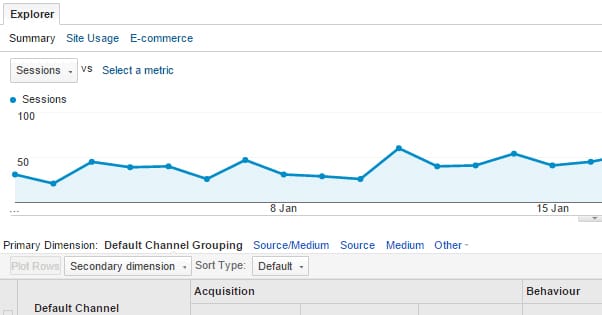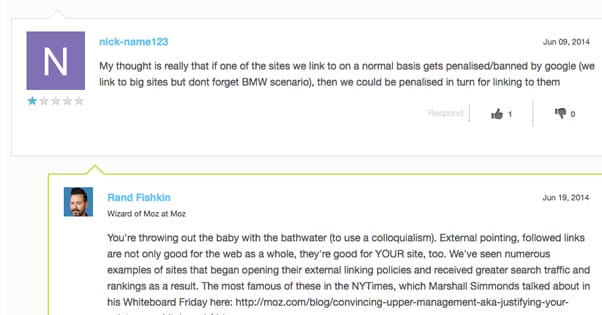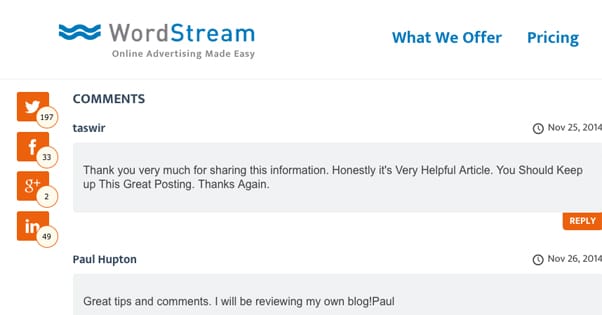10 Reasons Why Your Blog Isn’t Growing Fast Enough
Published by James Parsons • Content Marketing • Posted August 4, 2016 ContentPowered.com
ContentPowered.com
Once, I decided to count the number of stars in the sky. I was young, and had the patience of a particularly energetic puppy, so I didn’t get very far. My conclusion was that there were at LEAST 15 stars up there. While true, it was a pretty vast understatement.
If you tried to count the number of blogs out there, even if you were limiting yourself to your own target niche, you’d experience a similar phenomenon. There are, conservatively speaking, way too many blogs on the web. They’re essential for every business, so every business has one, and a lot of other folks besides.
There are only so many people in the world. Of the entire population of the planet, only a percentage of them speak your language. Of those, only a percent of them are interested at all in your topic. Of those, only a percent of them are out looking for new content. Of those, only a percentage of them are in a position to be reached by your marketing. On top of all of that, there are only 24 hours in a day, and only a few of them are spent looking at online content for any given person. You’re working with a small subsection of a subsection of the attention of a subsection of people.
All this is just an extensive and obtuse way of saying that you need to work to gain an audience, and you need to make your best effort to do everything right, lest you lose your audience and your opportunity.
There are a lot of reasons why your blog might not be growing as fast as you would like. Some of them are simple, like measurement errors that make your growth seem slower than it is. Some are personal, like having much higher ideals for growth than are actually reasonable. Many, though, are mechanical; problems you can diagnose and fix to receive a boost in growth rate indefinitely. I’ve tried to limit my selected reasons to these issues, so you have actionable advice and steps you can take to improve immediately upon finishing this post.
1. Your Promotion Engine is Idling
Blogs rely on promotion. The better, more thorough your promotion, the faster your growth. Promotion comes in a wide variety of forms, though, so I made a checklist of what you should be doing.
- Email your mailing list with new content in a weekly digest, including at least one piece of content not published publicly, as incentive for users to join the list.
- Share your post on social media, ideally several times with different snippets, across the span of a few days or a week.
- Tag, mention, or email any influencer you mention or link to in your post.
- Share with any specific communities, groups, or forums that discuss the topic you covered in detail.
You can also run your best content through paid ads, though often businesses want to reserve their ads for high converting landing pages rather than blog posts, which is fine. It’s your decision.
You can also consider syndicating some of your content, though that’s a complex issue. Syndication has to be done right and in moderation for it to have a net positive effect on your site rather than someone else’s.
2. You’re Not Repurposing Great Content
Sometimes one singular piece of content will hit the right topic at the right time, and it will go viral. Viral posts are high in volume but short-lived in nature, and we always wish we could extend that value. The fact is, you can. You just need to take the best performing content you’ve created and repurpose it.
Here are some ideas:
- Convert a blog post into an ebook by doubling or tripling the length of the content with added value, then sell it.
- Convert a blog post into a slideshare presentation.
- Convert a blog post into a YouTube video with animated graphics, or simply an audio podcast for people to listen to in other locations.
- Convert informational content into instructional content in the form of a webinar, DIY course, or paid group consulting session.
- Convert a larger overview-style post into a table of contents for individual drill-down posts about each individual sub-topic of the main post.
One single piece of content doesn’t have to remain one single piece of content. It can be repurposed, split up, or embellished to create more value for more people, as well as to bring in a wider audience. Plus, it’s a lot less work to expand upon an existing piece of content than it is to come up with an entirely new one.
3. You’re Not Focused on a Single Topic
Blogs require focus. Very, very few sites online today are generalist sites. Even a site like Reddit isn’t really a single site covering a broad array of topics; they’re a network of thousands of sub-sites covering more specific topics.
There are two reasons for the focus requirement. The first is your audience. When someone is looking for advice on cars, they want to read it on a site that focuses on cars. When you go to a doctor, you want that doctor to have studied medicine, right? You don’t want a doctor who only has a general studies degree.
The second reason is search optimization. Google takes that concept of audience and applies it to content analysis. They know information about cars is more likely to be valid coming from a site that writes about cars than it is from a site that writes about everything under the sun.
On top of that, when you drill down to specific posts, you need to be hyper-focused on a single narrow topic, like a single specific car or a specific function of an engine, or what have you. This way when people search for information about that specific topic, they can find you. If someone is having issues with their radiator they aren’t going to search for “car trouble” they’re going to search for the make, model, year, and the word radiator.
4. Your Blog is Focused on You
Yes, I know businesses use blogs as marketing tools. I know they’re designed for you to promote yourself. However, anyone can do that self-promotion. Anyone can say “I have X product, you should buy it.” That’s not the purpose of a blog, though, that’s the purpose of ads and commercials. The blog is not meant to answer the question of what you have for sale, it’s meant to answer the question of why a user should buy from you.
Nine times out of ten, the reason a user buys with company A over company B is because A did a better job of proving that they’re trustworthy and they know their stuff. They do this by having a blog that provides information with a minimum of sales talk. Users come to your blog to find solutions to their problems and data for their own purposes. If you provide that, you prove yourself a trustworthy brand, and they’ll be more inclined to research what your product is, or to buy it when they encounter it.
5. You’re Not Part of the Community
Industries have established gurus, authorities, and sites that everyone references. There are a lot of them in marketing, for example. You have Moz, you have Jon Loomer, you have WordStream, you have PostPlanner, you have Hubspot, and dozens more. You’ll notice that a lot of sites in the niche network with each other. They link to each other, they interview each other, and they guest post with each other. Many of the top tier writers contribute to a lot of them, or even all of them, in the case of some of the more prolific writers.
You need to make yourself part of the community. You need to respect the people with more experience than you. You need to link to them as references, and learn from them. You need to mention them when you link to them, to get their attention. You need to socialize with them on social media and in communities, so you too can be one of them eventually.
6. You’re Not Building Your Own Community
One thing that really helps blogs thrive is gathering their own communities. You don’t want to just be an outsider tapping into the “marketing community.” You want to be someone with your own site community or brand gathering. You should have your own Facebook groups, your own Twitter conversation hashtags, and your own dedicated commenters in your blog comments section.
If you have enough active people, you can even build a forum or create your own subreddit. However, I generally recommend this only to the largest brands, as a smaller brand won’t have many people in such a community, and there’s very little sadder than a forum with only a half-dozen active users.
7. Your Content is Superficial
I see this one a lot with small business blogs that want to get into a niche but don’t have the resources to really dig deep into their industry. Seeing the 10,000th “beginner’s guide to SEO” really starts to chafe. There’s nothing new to their post, it’s not deeper or more reliable or better written than the existing guides from much bigger brands. It’s just filler content, really. It doesn’t bring real value, it just makes the site look full.
Admittedly, it is hard for a small business to really get into unique content. You have to ply your unique situation and look for perspectives or experiences that other people don’t have. The trouble is, as a small business in a popular niche, there’s very little you’ve experienced that others haven’t. On top of that, being too reliant on your own stories goes against number four on this list as well.
8. You’re Not Consistently Active
There’s a lot of discussion about how often you should post to a blog. Disregarding all of it, I can boil it down to one single rule of thumb.
Post as often as you can support on a regular basis.
What this means is that you should never set an editorial schedule that relies on more content than you can publish regularly. If you can only count on publishing one blog post per week, start there. If you can’t manage that, well, maybe blogging isn’t for you. You may need to learn how to rely on ghostwriters to produce the content for you, which is a viable option, but you still need to come up with the content.
Additionally, don’t fall into the trap of thinking a couple of productive weeks means you can bump up your schedule. If you don’t have at least a month’s worth of backlog, ideally more, you don’t have enough content production to support increasing your publication speed.
9. Your Site Sucks, Mechanically
A modern site needs a certain standard of design. You need to have a responsive design, so you’re visible to both mobile and desktop users with equal validity. You need to have a robust navigation structure that doesn’t make it impossible to find what a user might be looking for. You need to minimize the number of ads you have on the site, so they aren’t plastered everywhere.
One of the modern usability trends I hate is the layered CTAs. I’ve seen sites that start with a roll-down shutter ad, that turns into a top bar ad when you close it. Scroll down a bit and a time-delay or scroll-delay window pops over the content. Close it and scroll more and a corner window box shows up to nag you some more.
It works, somewhat, for now. The trick is, the validity of the overt CTAs is dropping, and I would expect them to be minimally effective within the next few years. Better to pick one or two methods now and go for quality over quantity. Be ahead of the curve.
10. You’re Invisible to Search
There are a lot of different reasons why you might not be showing up in Google search results. The biggest are search penalties and mechanical errors. I don’t have room to go into all of them here, but that’s okay, because we covered it before. Check for code or server-related errors, diagnose possible penalties, and try to get your site squeaky clean to give your blog the best chance to thrive.










